s5cs50 functional programming
Yet another programming language, but it's OK because we'll be using Python as well as Haskell.

Yet another programming language (and only AQA), but it's OK because we'll be using Python as well as Haskell.
We are learning ...
About the meaning of the term function
How to implement functions in a functional programming language
Applications of functional programming
So that we can ...
State the format of a function as ⨍ : A ↦ B
- A ↦ B is the function type
- A is called the argument type or domain
- B is called the result type or co-domain
- A and B are always subsets of objects
Functions map one set of values (domain) to another set of values (drawn from codomainI have no idea what this means)
Describe a function as a first class objectI have no idea what this means in functional programming
State that a function application means a function applied to it's arguments
State what is meant by partial function application for one, two and three argument functions
State what is meant by composition of functions
Show experience of constructing simple programs in a functional programming language
- Map
- Filter
- Reduce / fold
Higher order functions
Be familiar with representing a list as a concatenation of a head and a tail
- The head is an element of a list
- The tail is a list
- The list can be empty
- Operations (return head, return tail, test for empty list, return length of list, construct empty list, prepend an item to a list, append an item to a list)
- Have experience writing programs for list operations in functional programming language
Application of functional programming to big data / distributed code
Up until now, we have mainly been learning procedural and object-oriented programming. We dabbled a little with a declarative programming language (SQL) but now, we learn the fundamentals of a fully blown declarative language!
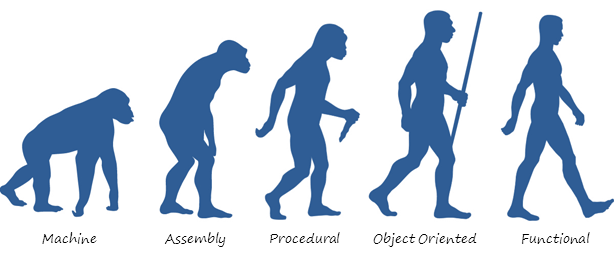
We have met functions before. A function is a rule which relates an input to an output. It maps values in a domain to values in a codomain. The values in the codomain to which our function maps are in the range of the function. We met this definition before when we learnt about vectors.
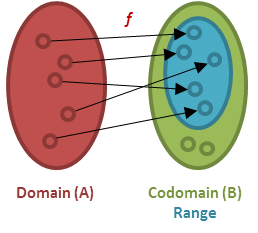

Task 1.1 Maths is fun!
Visit the Maths is Fun website and read through the following pages ...
Make notes and answer questions 1 to 10 at the bottom of each page.
OUTCOME : Notes on functions, domain, range and codomain when applied to functions.


Function type
The domain and the codomain are also related to the function type. The type of a function states the data type of the argument the function requires (the value in the brackets) and the data type it will return. All elements in the domain must be of the same type as must all elements in the codomain.
The type of function f is written as ⨍ : A ⟼ B where A is the type of the domain and B is the type of the codomain.

Task 1.2 Function types
1
⨍ : Integer ⟼ Integer
2
⨍ : Integer ⟼ Real
3
⨍ : Char ⟼ Integer
4
⨍ : String ⟼ Integer
5
⨍ : Real ⟼ Bool
OUTCOME : Examples of function types stated.



Activity 2
Functional programming
Before you start, forget everything you already know about programming (eek!) You don't think imperatively and you don't code imperatively. Everything in functional programming is a function, just like everything in object oriented programming is an object (although the methods you code are imperative!) You have to think of the world as functions. Clearly, applications of functional programming lean towards mathematical problems which require lots of calculations.
In functional programming ...
functions are pure - they only modify their parameters and nothing else which prevents side effects;
functions with no arguments are called definitions (we'd know them as assignment);
useful functions return a value;functions are predictable - they always produce the same outputs given the same inputs;
there are no variables!
there are no loops so we have to use recursion ::smile::

OK, OK, keep calm ... here comes the maths!
Function application
In mathematics, function applicationI have no idea what this means is the act of applying a function to argument(s), drawn from the domain, A, so as to obtain the corresponding value from its range within the codomain, B.
To define a function to
doublexdef double(x): return x*2...whereas in a functional programming language, like Haskell, we write it like this ...
double x = x * 2In imperative languages, function application is denoted using parentheses whereas in functional languages it is denoted using a space. In each case,
xdoubledouble(x)double xTask 2.1 Function application
In your notebooks : Explain the meaning of function application using suitable examples which are different than the examples I have used.
OUTCOME : Your own examples of function and partial function application


Practical functional programming
To learn some functional programming, we're going to use a very widely implemented platform called Haskell.
You may wish to spend a little time on the tutorial that you can access by typing help in the 'Try It' section next to the lambda (λ) symbol (derived from it's history in Lambda calculus) ... see how far you can get before you get confused! To progress further, you can either install Haskell yourself on your own computer or ask your teacher to install it on your lab computers at school.
On Windows, Haskell comes with an interactive tool called WinGHCi or the Glasgow Haskell Compiler (Interactive) into which you can issue Haskell commands interactively or load and execute scripts.

The Glasgow Haskell Compiler (Interactive) running on Windows

Task 2.2 Keep it simple, Haskell!
To be honest, learning a whole new programming paradigm might be a bit too much to ask at this stage. However, I would like you to have a go the first part of the first chapter of the book Learn You a Haskell for Great Good up to but not including 'An intro to lists' - we'll cover that part later.

Use WinGHCi to try out the commands that you are taught. Don't worry about evidencing what you have done but do answer the following questions in your notebooks ...
1
How do you carry out simple mathematical operations using Haskell?
2
What are the symbols for Boolean
ANDOR3
What are the symbols for equality and inequality in Haskell?
4
What does the Haskell
succ5
What do the Haskell
minmax6
How do you create a simple function in Haskell? Can you give an example?
7
How do you use selection in functions in Haskell? Why is the
else
I bought a copy, so should you!
OUTCOME : Simple Haskell examples to whet your appetite.

First class objects / values
A first class object / value is any object / value that can ...
appear in an 'expression';
be assigned to or named by a variable / identifier
be stored in a list or a dictionary
be passed as arguments to a function
be returned from a function
... which pretty much covers everything in most modern programming languages. As you can imagine, by these definitions, all simple scalarI have no idea what this means data types such as integer, float, bool and char are first class objects and so are data structures which contain them. In Python, objects also act as first class as we have seen before when we have included objects assigned to variables, stored in lists, passed as parameters to functions or returned from functions.
Task 2.3 First class objects
Your challenge is to come up with one example of either a scalar data type (EASY), a data structure (HARDER) or a simple object (HARDEST) and demonstrate it behaving like a first class object in Python. Present your findings using a suitable combination of screenshots and written explanation.
OUTCOME : A first class object behaving like a first class object.

Lambda functions

lambda
Try using Lambda to create an anonymous function.
>>> lambda x : x*2
<function <lambda> at 0x02FFCC00>This is clearly a function (because it says so) but we have no way of 'holding' onto the lambda function - it is anonymous and has no identifier! So, let's give it one.
>>> double = lambda x : x*2
>>> double(4)
8We've created a function called double and we've assigned it straight to a variable (first class) so it acts like a value! Nooo way!! We could have done this ...
>>> def double(x):return x*2
>>> double(4)
8...so why bother with lambda? Mainly because it's easier and clearer but mainly because it is the only sensible way (not the only way) of including a function inside another function. Seriously, you'll see the benefit of using lambda later on. We can even pass a lambda function as a parameter to another function ...
>>> def fourtimes(function,parameter):
return function(parameter) * 2
>>> fourtimes(lambda x: x*2, 4)
16
Here, the function
fourtimesmapfilterreducefoldWhat about this?
>>> def exponent(n): return lambda m : m**n
>>> exponent(3)
<function exponent.<locals>.<lambda> at 0x02FFCD20>
So, the function exponent returns an actual function - this is clear (and totally first class). The function
exponentIf you think about it, if
exponentmWe can complete the application of the function by using it to create other functions, like this ...
>>> cube = exponent(3)
>>> cube(2)
8
>>> cube(3)
27
Wow! Like, wow! The function
cubeFinally, let's create a list of anonymous functions and access them like value ::exploding_head:: to complete our proof of first classness!
>>> myfunctions = [lambda n:n*1,lambda n:n*2,lambda n:n*4]
>>> myfunctions[0](2)
2
>>> myfunctions[1](2)
4
>>> myfunctions[2](2)
8
Here, we've seen lambda functions behaving in a truly first class fashion. Nice.

So is mine!
Task 2.4 Lambda functions
Anonymous lambda functions are somewhat of a mystery to most beginning Python programmers, but not you! Try the following exercises, providing evidence of what you have done through a suitable combination of screenshots and written explanation.

Create a lambda function,
halfCreate a lambda function,
reciprocalCreate a new function,
polynomialUsing the existing function,
exponentsquarerootCreate a new function,
incrementernmm + nsuccessorpredecessorFinished? Have a quick read through 'Yet Another Lambda Tutorial' - are you a convert?
OUTCOME : Some groovy lambda functions.


Luckily, if we use Haskell, we don't generally have to use lambda functions for simple operations like this because in Haskell, the way that functions are defines is quite lambda like anyway. The safest way to conduct the next set of exercises is to use a script rather than the interactive console. Often Haskell requires you to be more explicit about the function types that you are defining and you can't define function types in Haskell at the interactive prompt ::pensive::

Using your favourite text editor, create the a script called activity2.hs and save it in a suitable place. Make sure that the file extension is correct and close down your text editor. Now open up WinGHCi (if you haven't done already) and choose 'File > Load' and load in the script you have created. These are the two toolbar buttons you'll need next ...
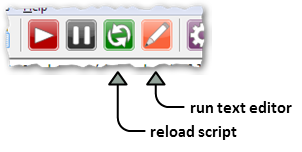
Once the file is loaded, hit the 'Run Text Editor' button and Notepad should appear, as if by magic. Use WinGHCi and the default text editor to carry out the following tasks. Edit the script in the text editor, click save and then click the 'Reload Script' button before executing the commands given at the interactive prompt. Here we go ...
We can define the same double function in Haskell like this ...
In the text editor ... (save)
-- Define double function
double :: Integer -> Integer
double x = x * 2In WinGHCi ... (reload file and execute)
*Main> double 4
8In the text editor, you declare the function type explicitly so that Haskell knows what data type to expect and what data type it's meant to return. We can then use this double function in another function ...
In the text editor ... (save)
-- Define double function
double :: Integer -> Integer
double x = x*2
-- Define quadruple function
quadruple :: Integer -> Integer
quadruple x = double (double x)
In WinGHCi ... (reload file and execute)
*Main> quadruple 4
8This is a very simple example of a very common pattern you see in Haskell where basic functions are designed and combined to create more complex functions. Partial function application in Haskell is also straightforward. The exponent examples we saw before is easy but we need to make sure we declare a specific function type to allow us to perform all the operations we did with Python before.
In the text editor ... (save)
-- Define double function
double :: Integer -> Integer
double x = x*2
-- Define quadruple function
quadruple :: Integer -> Integer
quadruple x = double (double x)
-- Define exponent' function
exponent' :: Float -> Float -> Float
exponent' x y = x ** y
In WinGHCi ... (reload file and execute)
*Main> exponent' 2 3
9.0
*Main> cube = exponent' 3
*Main> cube 2
8.0
*Main> cube 3
27.0
Notice the the prime (') character after the
exponent'
For the next section, unload the script by typing
:m*Main>Prelude>Prelude> multiplier = \x n -> x*n
Prelude> doubler = multiplier 2
Prelude> doubler 4
8
Prelude> tripler = multiplier 3
Prelude> tripler 4
12
Prelude> halver = multiplier 0.5
Prelude> halver 4
2.0Don't worry too much if you aren't really following this (I wouldn't be surprised). Later on when we look at the main higher order functions
mapfilterreducefold
Task 2.5 Haskell functions
Using the text editor and Haskell, your task is to try to construct some of the functions as you did using Python in Task 2.4. This will help you to practice constructing explicit function types in Haskell (which is like the ones you'll see on the examination!)

Create a Haskell function,
halfCreate a Haskell function,
reciprocalCreate a Haskell function,
polynomialUsing the existing Haskell function,
exponent'squarerootCreate a new function,
incrementermnm + nsuccessorpredecessorOUTCOME : Some groovy lambda functions.



Yeah, right

Activity 3
Map, filter and fold
The three most common functions which facilitate a functional approach to programming in Python are
mapfilterreduce
Ok, OK - here we go...
Map
The map function takes a list of values from a domain and applies a function to each value in the list, mapping the value to a range in the subdomain (remember them?)

The map function using a lambda function

The map function is built into the standard Python library so it's always available (noice). The blueprint is ...
map(function, *iterable) --> map objectThe
maplist(object)mapmap>>> list(map(ord,'Hello there!'))
[72, 101, 108, 108, 111, 32, 116, 104, 101, 114, 101, 33]
... and this one converts a list of numbers into a list of strings.
>>> list(map(str,[1,2,3,4,5]))
['1', '2', '3', '4', '5']
If the function takes more than one parameter, simply pass
mappow(x,y)x**y>>> list(map(pow,[5,4,3,2,1],[1,2,3,4,5]))
[5, 16, 27, 16, 1]
Consider this mathematical delight ...
>>> import math
>>> list(map(math.sin,[34,54,65]))
[0.5290826861200238, -0.5587890488516163, 0.8268286794901034]
As you can imagine, you can also put lambda functions in the
mapmap>>> list(map(lambda x:x**2, [1,2,3,4,5]))
[1,4,9,16,25]
It's common to separate the function from the map operation, which would be especially useful if the function was more complicated. For instance ...
>>> double = lambda x:x**2
>>> list(map(double,[1,2,3,4,5]))
[1,4,9,16,25]
We can also design a map function which capitalises every letter in a string.
>>> ''.join(list(map(lambda x:chr(ord(x)-32),'hello')))
'HELLO'
The list is literally endless ...

Task 3.1 Map in Python
Write map functions for the following situations. I've given you a hint on the first four ...
Generate a list of the lengths of names in this list
names = ['Charles','Andrew','Bob','Leanne','Beatrice']Generate a list of the hex codes for
[85,18,171,255,0]Generate a list of the types for
[1,True,'Hello',12.44]Generate a list of the absolute values for
[-5,12,-6,10,-7,-1]Use a suitable lambda function to generate a list of the successors to
Use a suitable lambda function to add together the two vectors [1,2,3,4,5][3,5,4][1,3,4]
OUTCOME : Evidence that you can use the map function in context.


It's worth noting that the result of the map function can be achieved using list comprehensions. For instance, both these statements are equivalent ...
>>> list(map(lambda x:x+1,[1,2,3,4,5]))
[2,3,4,5,6]
>>> [x+1 for x in [1,2,3,4,5]]
[2,3,4,5,6]

Neither!

In Haskell, the map function is structured like this ...
map (function) [list]The function can be a simple partial application like
(+1)(\x -> x + 1)Predule> map (+1) [1,2,3,4,5]
[2,3,4,5,6]
Prelude> map (\x -> x+1) [1,2,3,4,5]
[2,3,4,5,6]
Haskell has many built in functions which we can use in the map function. For instance ...
Prelude> map (odd) [1,2,3,4,5]
[True,False,True,False,True]
Unfortunately, you can only provide one list as an argument to the Haskell
mapPrelude> zip [5,7,6] [1,4,5]
[(5,1),(7,4),(6,5)]
The
zipmapPrelude> map (\(x,y) -> abs(x-y)) (zip [5,8,3] [6,6,6])
[1,2,3]
Prelude> map (\(x,y) -> maximum [x,y]) (zip [4,6,8] [1,2,9])
[4,6,9]
The first example generates a list of the absolute difference between related values in the lists and the second example generates a list of the maximum related values from the lists. Nice.

Task 3.2 Map in Haskell
Write map functions for the following situations in Haskell. I've given you a hint on some of them ...
Generate a list of the lengths of names in this list
names = ["Charles","Andrew","Bob","Leanne","Beatrice"]Generate a list of the even Bools (i.e. true/false) for
[1,2,3,4,5]Generate a list of the absolute values for
[-5,12,-6,10,-7,-1]Generate a list of the predecessors to
[1,2,3,4,5]Use a suitable lambda function and the
zip[3,5,4][1,3,4]Use a suitable lambda function and the zip operator to find generate a list containing the minimum values of the corresponding values in
[4,6,8[1,2,9]
OUTCOME : Evidence that you can use the map function in context.


Once again, it's worth noting that the same can be achieved using list comprehensions. We haven't looked at list comprehensions in Haskell yet (and neither are we going to), however, you should be able to apply simple patterns using these examples. Notice the left facing '
<-Prelude> [x+1 | x <- [1,2,3,4,5]]
[2,3,4,5,6]
Prelude> [maximum [x,y] | (x,y) <- (zip [4,6,8] [1,2,9])
[4,6,9]

You've already asked me that!
Filter
The
filtertrue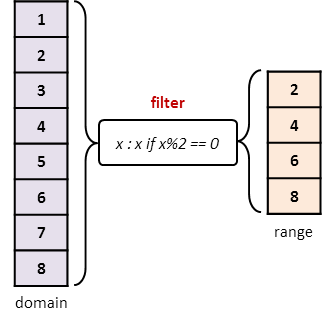
The filter function through the application of a lambda function

The filter function is also built into the Python standard library, so it's always available. The blueprint is ...
filter(function, iterable) --> filter objectWhere the function is a conditional statement which returns
truefalse>>> list(filter(lambda x:x%2==0,range(1,21))
[2, 4, 6, 8, 10, 12, 14, 16, 18, 20]
... extracting odd numbers from a list ...
>>> list(filter(lambda x:x%2==1,range(1,21)))
[1, 3, 5, 7, 9, 11, 13, 15, 17, 19]
You can truncate a list based in the value ...
>>> list(filter(lambda x:x>0,range(-5,5))]
[1,2,3,4]
... and even use string operations to search for matching values in a list or words.
>>> names = ['Anne', 'Amy', 'Bob', 'David', 'Carrie', 'Barbara', 'Zach']
>>> list(filter(lambda s: s.startswith('B'), names)
['Bob', 'Barbara']
>>> list(filter(lambda s: 'a' in s.lower(), names)
['Anne', 'Amy', 'David', 'Carrie', 'Barbara', 'Zach']


Task 3.3 The filter function in Python
Use a combination of
listfilterlambdaWrite a
filterWrite a
filterbool[1,2,True,3,4,False]Declare a list of names of various length ...
names = ['Odis','Jovan','Tinisha','Gerda','Ayesha','Dorsey','Elton','Laila','Petronila']... and write a
filterOUTCOME : Various applications of the filter function


It is worth noting that you can achieve pretty much the same outcomes using list comprehensions. For instance, we can generate our list of even and odd numbers like this ...
>>> [x for x in range(1,21) if x%2 == 0]
[2, 4, 6, 8, 10, 12, 14, 16, 18, 20]
>>> [x for x in range(1,21) if x%2 == 1]
[1, 3, 5, 7, 9, 11, 13, 15, 17, 19]
... which some programmers find easier / clearer.

This is getting silly. Stop asking me!
In Haskell, we use the
filterfilter (predicate) [list]... where the
predicatetruefalsetruefalsefilterWe can filter out all odd values from a list like this ...
Prelude> filter (even) [1,2,3,4,5]
[2,4]
Notice the result of the application of even in this case is very different to that of its use in the
mapPrelude> filter (>0) [-5..5]
[1,2,3,4,5]
Prelude> filter (==3) [-5..5]
[3]

... but perfectly valid as long as the ranges are predictable!
Both these predicates are statements not functions (technically,
>==>0x>0Prelude> filter (\x -> x>0) [-5..5]
[1,2,3,4,5]
Prelude> filter (\x -> x==3) [-5..5]
[3]
Once again, it's worth noting that we can use list comprehensions in Haskell to achieve the same outcome ...
Prelude> [x | x <- [-5..5], x>0]
[1,2,3,4,5]
Prelude> [x | x <- [-5..5], x==3]
[3]
No, no no!
We could define a slightly more complicated (and totally pointless) even number filter in three slightly different ways (just to prove some points and introduce some other points) ...
a) Using the built in even function as the predicate. We've seen this before ::smile::
Prelude> filter (even) [1..10]
[2,4,6,8,10]
b) Using a lambda function. This uses the Haskell mod operator which prefixes it's arguments.
Prelude> filter (\x -> mod x 2 == 0) [1..10]
[2,4,6,8,10]
c) Using a lambda function. I've modified the mod operator to an infix operator by surrounding it with backticks.
Prelude> filter (\x -> x `mod` 2 == 0) [1..10]
[2,4,6,8,10]
d) Defining a separate function and using that as the predicate. Sometimes better, sometimes not.
Prelude> evens x = mod x 2 == 0
Prelude> filter (evens) [1..10]
[2,4,6,8,10]
e) Using function composition. You should have met function composition in Task 1.1...
Prelude> filter ((==0).(`mod` 2)) [1..10]
[2,4,6,8,10]The predicate is evaluated from right to left. For each value in the list, the result of the
mod==0True 1 : 1 `mod` 2 = 1 -> 1 == 0 -> False
2 : 2 `mod` 2 = 0 -> 0 == 0 -> True -> Add 2
3 : 3 `mod` 2 = 1 -> 1 == 0 -> False
4 : 4 `mod` 2 = 0 -> 0 == 0 -> True -> Add 4
5 : 5 `mod` 2 = 1 -> 1 == 0 -> False
6 : 6 `mod` 2 = 0 -> 0 == 0 -> True -> Add 6
7 : 7 `mod` 2 = 1 -> 1 == 0 -> False
8 : 8 `mod` 2 = 0 -> 0 == 0 -> True -> Add 8
9 : 9 `mod` 2 = 1 -> 1 == 0 -> False
10 : 10 `mod` 2 = 0 -> 0 == 0 -> True -> Add 10

Even though we learnt that the open circle (∘) represents function composition, there is no open circle available to show this in Haskell (or any other language), so the dot is used. Sorry ::pensive::
Task 3.4 The filter function in Haskell
Use the
filterWrite a
filter[1..10]Write a
filterlambdathreesDeclare a list of names of various length ...
names = ["Odis","Jovan","Tinisha","Gerda","Ayesha","Dorsey","Elton","Laila","Petronila"]... and write a filter function to generate a list which only contains names over 6 characters in length. You should do this using a
lambdalongOUTCOME : Various applications of the filter function in Haskell.

Reduce / Fold
Finally, the
reducefoldreducefrom functools import reduce...before we can use it. Basically, reduce takes a list and, through the application of a function, reduces the list to a single value.
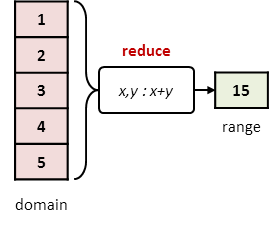
The reduce operation using a lambda function

The
reducereduce(function, iterable[, initialiser])The function takes two arguments due to the way it operates on the list. Consider this simple
reduce>>> reduce(lambda x,y:x+y,[1,2,3,4,5],0)
15
The operation of
reduce(((((0+1)+2)+3)+4)+5)You can also use
reduce>>> reduce(lambda a,b:a if a>b else b, [45,12,102,14,9])
102
The
reduce>>> names = ['British','Broadcasting','Corporation']
>>> reduce(lambda a,b:a+b[0],names,'')
'BBC'
Notice that the initialiser for this operation is an empty string. Try it without that and see what happens (lol).

Task 3.5 Reduce
Use a combination of
reducelambdaWrite a
reduce[1,2,3,4,5]Write a
reduce[45,12,102,14,9]Write a
reduce[12,6,6][13,12,10]Write a
reduce
OUTCOME : Applications for the reduce function


There is no reduce function in Haskell ::face_with_rolling_eyes::; it's called
foldfoldlfoldrThe blueprint for the functions is ...
foldl (function) initialiser [List]
foldr (function) initialiser [List]The initialiser gives a special variable called the accumulator its initial value. The
foldlfoldrHere is a nice way of looking at both situations based on a common food chain.
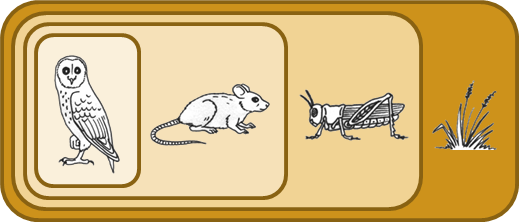
Demonstrating a left fold
In a left fold, the food chain is accumulated from the owl to the grass; from left to right. The owl eats the mouse, then the owl (which has eaten the mouse) eats the grasshopper and finally the owl (which has eaten the mouse and the grasshopper) eats the grass.

Demonstrating a right fold
In a right fold however, the food chain is accumulated from the grass to the owl; from right to left. The grasshopper eats the grass then the mouse eats the grasshopper (which has eaten the grass) then the owl eats the mouse (which has eaten the grasshopper which has eaten the grass). In any event, the owl is full up.
Enough about food. Consider these two real examples ...
Prelude> foldl (+) 0 [1,2,3,4,5]
15In essence, the
foldl(((((0+1)+2)+3)+4)+5) = 15Prelude> foldr (+) 0 [1,2,3,4,5]
15In essence, the
foldr(1+(2+(3+(4+(5+0))))) = 15In this instance, the order of the fold makes no difference to the result since addition is commutative (order is unimportant). However, subtraction is not and the following two functions yield very different results.
Prelude> foldl (-) 0 [1,2,3,4,5]
-15
Prelude> foldr (-) 0 [1,2,3,4,5]
3Why does this happen? Let's evaluate the expression manually to find out ...
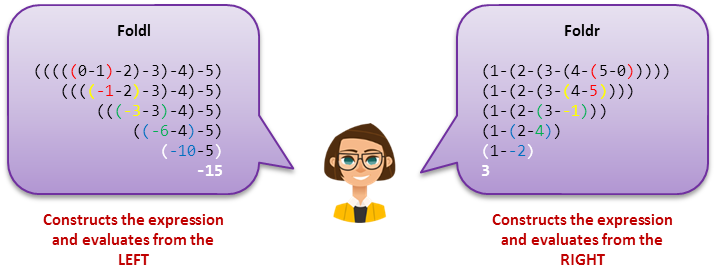

Task 3.6 Folding with Haskell
Use a the Haskell
foldlWrite a
foldl[1,2,3,4,5]Write a
foldl["H","E","L","L","O"]
OUTCOME : Applications for the fold function



Do not attempt this section unless you are ready for a challenge!
This situation gets even more complicated with function composition and we are really getting way out of our depth here! However, when we were using Python, we managed to generate an acronym for the British Broadcasting Corporation using a Lambda function. However, the same process in Haskell is slightly more confusing (but I feel duty bound to tell you about it). The
foldlfoldrPrelude> foldl (\acc a -> acc ++ take 1 a) "" ["British","Broadcasting","Corporation"]
"BBC"
Prelude> foldr (\a acc -> take 1 a ++ acc) "" ["British","Broadcasting","Corporation"]
"BBC"However, trying to use normal function composition causes problems ...
Prelude> foldl ((++).(take 1)) "" ["British","Broadcasting","Corporation"]
"BCorporation"
Prelude> foldr ((++).(take 1)) "" ["British","Broadcasting","Corporation"]
"BBC"The
foldl(take 1 (take 1 (take 1 "" ++ "British") ++ "Broadcasting") ++ "Corporation)
(take 1 (take 1 "British" ++ "Broadcasting") ++ "Corporation)
(take 1 "BBroadcasting" ++ "Corporation)
"BCorporation"The
foldr(take 1 "British" ++ (take 1 "Broadcasting" ++ (take 1 "Corporation")))
(take 1 "British" ++ (take 1 "Broadcasting" ++ "C"))
(take 1 "British" ++ "BC")
"BBC"... which explains it all, quite clearly!

... and no task!

Activity 4
List operations
Back to Haskell for this last section and the fabulous 'Learn You a Haskell for Great Good' - my favourite book!
Task 4.1 Learn me a Haskell
Go back onto the web version of Learn You a Haskell for Great Good and continue working through the first part of the first chapter up to but not including 'Texas Ranges'.

Again, use WinGHCi to carry out the exercises in the book, reading the explanations carefully. Don't worry about evidencing your progress but do answer the following questions in your notebooks.
How do you define a name in Haskell?
What is the difference between the
++:Describe how you would prepend and append an item to an existing list.
What does
[[],[],[]]Write a Haskell command to retrieve the 4th item from the list
[6,5,4,3,2]How do list comparisons work in Haskell?
Draw a picture to represent the
headtailinitlastDescribe the purpose of the following list functions ...
-
length-
null-
reverse-
take-
drop-
maximum-
minimum-
sum-
product-
elemOUTCOME : Descriptions of common list operations


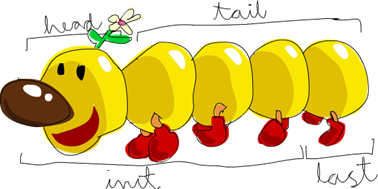
Hello little caterpillar!
Extension Activities
How about these?
Visit Haskell's documentation page to find a list of resources to help you learn Haskell.
Read and enjoy 'Learn you a Haskell for Great Good!' - Holy Sh*t!
Read this series of interesting articles on how to be a functional programmer.
What's next?
Before you hand your book in for checking, make sure you have completed all the work required and that your book is tidy and organised. Your book will be checked to make sure it is complete and you will be given a spicy grade for effort.
Before you hand your book in for checking, make sure you have completed all the work required and that your book is tidy and organised. Your book will be checked to make sure it is complete and you will be given a spicy grade for effort.
END OF TOPIC ASSESSMENT
Last modified: February 14th, 2024
























